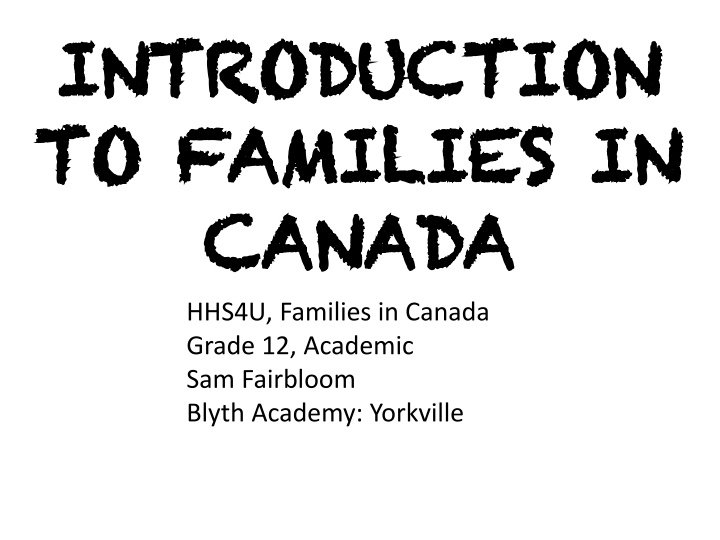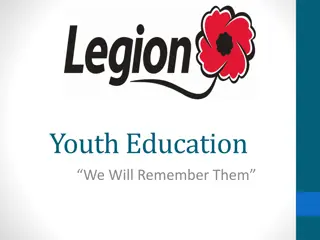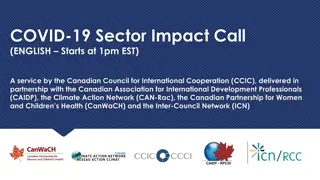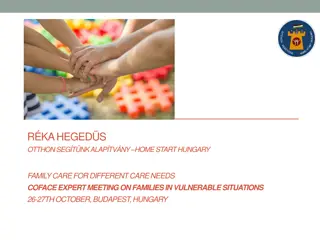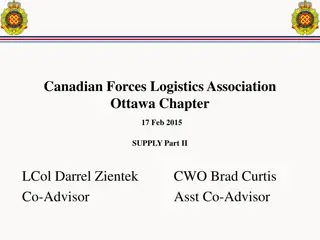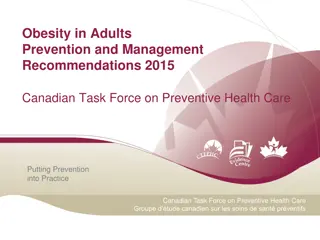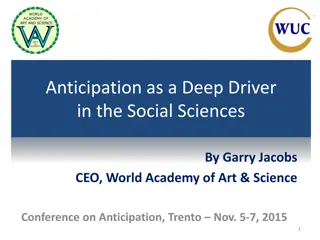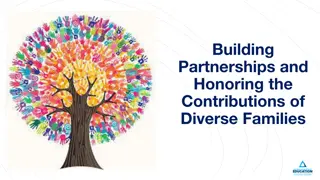Canadian Families Through Social Sciences
Delve into the dynamics of Canadian families from birth to death through the lenses of sociology, anthropology, and psychology. Understand the behavior, beliefs, and interactions within family settings. Gain insights into how marriage and family shape society. Explore cultural norms and individual development in family contexts. Discover the significance of social sciences in comprehending families and society.
Uploaded on Mar 14, 2025 | 2 Views
Download Presentation

Please find below an Image/Link to download the presentation.
The content on the website is provided AS IS for your information and personal use only. It may not be sold, licensed, or shared on other websites without obtaining consent from the author.If you encounter any issues during the download, it is possible that the publisher has removed the file from their server.
You are allowed to download the files provided on this website for personal or commercial use, subject to the condition that they are used lawfully. All files are the property of their respective owners.
The content on the website is provided AS IS for your information and personal use only. It may not be sold, licensed, or shared on other websites without obtaining consent from the author.
E N D
Presentation Transcript
INTRODUCTION INTRODUCTION TO FAMILIES IN TO FAMILIES IN CANADA CANADA HHS4U, Families in Canada Grade 12, Academic Sam Fairbloom Blyth Academy: Yorkville
Sam Fairbloom B.A., English Language and Literatures, University of Western Ontario B.PS., Intermediate/Senior, Niagara University English Social Sciences
Disciplines in the Social Sciences Discipline: a specific branch of learning such as math, psychology, geography. Choosing a discipline determines what observations you will make and which theoretical perspective will be used to organize and explain your ideas.
What is This Course About? Potentially investigating everything that can occur to families from birth to death through a social science perspective: Social Sciences Psychology Anthropology Sociology
Sociology Anthropology Psychology SAP: Sociology, Anthropology, Psychology individuals as they interact in social groups, such as in family settings and different communities. a nation. It is the social science that explains the behavior of The study of human behavior and cultural factors the arts, the beliefs, habits, institutions that are characteristics of a specific community, society, or It is the study of behavior based on mental processes. It focuses on how the individual thinks. Sociologists are interested in the relationship between the institution of marriage and the institution of family because, historically, marriages are what create a family, and families are the most basic social unit upon which society is built upon. Both marriage and family create status roles that are sanctioned by society. Example: comparing rituals in different countries and how they differ with our initiation into adulthood. When it comes to family, psychologists focus on the individual s stage of development and his/her needs in defining the family. By reading the anthropological studies of other cultures, people learn to understand that all cultural behavior is invented. Therefore, the norms and culture that an individual follows in a family is invented. They also examine how individuals interact and influence one another, thereby affecting the family.
What would ____ ask? Select a topic that interests you about families in Canada. What would an anthropologists ask about the topic? What would a sociologist ask? What would a psychologist ask?
Why Should You Stay in This Course? Social sciences are important because they help students understand families, communities, and society of their own and of others, which helps them better understand themselves. Students leave the course with a better understanding of how people think, live, and interact with one another around the world in various cultures, communities, and societies. It is important that students develop their abilities to hold informed discussions on the world around them: social, cultural, economic, technological, environmental, and wellness issues , and the ability to comprehend complex issues, and diversity. Overall, social sciences are important because they prepare student for a world that does not exist and provides them the proper tools for understanding the world now, and in the future.
What can I do to Expect Success? There will not be a lot of homework in this class, so take advantage of class time Connect to the material Finish the assignments on time Interact and ask questions Take notes Connect the material to your everyday life
Course Website https://fairbloomhhs4u.wordpress.com/ Email: fairbloom.blyth@gmail.com
Unit Briefs 1. Approach to the Study of Families and Individuals 2. Individuals in a Diverse Society 3. Intimate Relationships and Marriage in a Diverse Family 4. Diversity The Global Network 5. Hot Topic Burning Issues 6. Independent Study Project
Categories of Mark Breakdown KICA Breakdown: Knowledge = 20% Inquiry/Thinking = 30% Communication = 20% Application = 30%
Introductions Fill out Questionnaire Your name University/College you want to attend OR what you hope to do after high school Places you want to travel and have traveled to Favorite and least favorite school subjects A little paragraph about your family
Goals of This Course You will To understand and appreciate the variability in Canadian families To understand the historical, cultural, and sociological roots of this variability To study how Canadian families reflect change in society, and how they shape change Learn about the research that scholars in this discipline conduct Develop your critical thinking ability Learn to distinguish between trustworthy and suspect sources of information Improve your communication skills
Textbook Tentative: Individuals and Families, Diverse Perspective: McGraw Hill & Ryerson
Definitions of the FAMILY: For the next five minutes, write down what you think the definition of family is and examples of families in Canada. Remember: Definitions of family have changed remarkably over the years.
The Basics of Family In all societies, individuals live in families. You were likely born and raised in a family. When you reach maturity, you will probably leave your family, and start a new family. This cycle of human life has continued for tens of thousands of years Each family is made up of several individuals. Therefore, to understand the family, one must understand the individual.
Sample Definitions A social group characterized by common residence, economic cooperation and reproduction. It includes adults of both sexes, at least two of whom maintain a socially approved sexual relationship, and one or more children, own or adopted, of the sexually cohabiting adults (Murdoch 1949). A married couple or other group of adult kinsfolk who cooperate economically and in the upbringing of children, and all or most of whom share a common dwelling. (Gough 1971). A residential kin group composed of a woman, her dependent children, and at least one adult male joined through marriage or blood relationship (Haviland 1997).
Statistic Canadas census family A now-married couple (with or without children of either or both spouses), a couple living common-law (with or without children of either or both partners), or a lone parent of any marital status, with at least one child living in the same dwelling. A couple living common-law may be of opposite or same sex. Children in a census family include grandchildren living with their grand-parent(s) but with no parents present.
Vanier Institute of the Familys Definition Any combination of two or more persons who are bound together over time by ties of mutual consent, birth, and/or adoption or placement and who, together, assume responsibilities for variant combinations of some of the following: Physical maintenance and care of group members Addition of new members through procreation or adoption Socialization of children Social control of members Production, consumption, distribution of good and services, and Affective nurturance love
Functions of a Family No society can survive unless the individual in a family has certain basic functions, such as reproduction, provision of food, educating their young etc. Function is a basic and universal action or purpose, such as reproduction or the provision of food, that enables individuals and families to survive. There are macro functions and micro functions. What do you think macro and micro functions might be?
Functions of the Family Responsible for the addition of new members through reproduction because of the extended dependency of infants. Families provide physical care for their members. Responsible for socializing children. Teaching them the norms and customs of the society. Responsible for controlling the behavior of their members to maintain order within the family and within the society in which they live. Responsible for maintaining more and motivate individuals to participate in society. Participation in appropriate social roles to the health of society (soup kitchen, volunteering, echoing).
Important Concepts Family of Origin or Family of Orientation: The family you were born into and/or raised in Family of Procreation: The family you form through marriage or cohabitation and in which you raise your children Nuclear Family: Usually regarded as married parents and their children standard North american family or SNAF (WARD 2006). Typically includes a couple and their children, sharing the same household (Albanese 2007).
Important Concepts Extended Family: The nuclear family and other relatives (Ward 2006). Several generations (grandparents, aunts, uncles, cousins) who share a household (Albanese 2007). A collective of nuclear families, related by ties of blood, that live together in one household (Haviland 1997). We all have various combinations of relatives who constitute near family and more distant family.
Three Main Eras Traders and trappers were around in the 17th & 18th centuries Few European women: Country wives Attempts by the government and church to regularize relationships, ensure a sufficient supply of women Effects on indigenous groups with forcible introduction of patriarchy. 1. Early Colonization (i.e. fur trade, exploration) Agricultural settlement Early industrialization 2. 3.
Settlers: 18th and 19th Centuries Farm families numerically predominant Work of all members required (men, women, younger children, older children) Benefits of large families Shop keeping, artisanal, and farm families of preindustrial times were laboring units, practicing an interdependent family economy By mid-19th century, the productive aspects of domestic labor by unpaid women and children were gradually moving into the marketplace Shift to early Industrialism (from 1850 on) produced separate spheres Wage labor took men out of and away from homes This coincides with emergence of cult of domesticity and relegation of women to the household sphere
Canadian Families in 2001 What are the major trends?
Household Trends More private households Fewer person per household Youth leaving home at later ages and returning More individuals living alone More three-generation families
Child Bearing Families have fewer children An increasing number of couples choosing to be childless
Marriage Fewer marriages, at later ages Increase in common law couples Increase in divorce rate
Aging Canada s population is aging In 2006, 13% of the population was over 65
Employment Dual income couples are the norm Half of all jobs created since 1991 are part-time, temporary, or result from self employment The new standard for employment is not the 40-hour daytime Monday to Friday full time job
